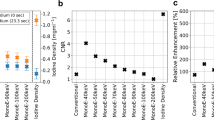Abstract
To evaluate the feasibility of myocardial first-pass perfusion imaging with multidetector CT (MDCT). In five pigs, myocardial infaction was induced by permanent balloon occlusion of the left anterior descending coronary artery. Dynamic contrast-enhanced MDCT (12×1.5 mm, 120 kV, 30 mAs, 64 acquisitions, 40 ml iopromide 370@4ml/s) and contrast-enhanced first-pass perfusion magnetic resonance (MR) imaging (TR 7.7 ms/TE 2.6 ms, 64 acquisitions, 0.05 mmol/kg Gd-DTPA) were performed. Finally, the animals were sacrificed, and the heart was excised and stained with triphenyltetrazolin-chloride (TTC). Maximum signal intensity (SImax), contrast material arrival time (CAT), wash-in time (Tmax) and slope were calculated from time-density/signal-intensity curves. The area of myocardial hypoperfusion was measured as the percentage of the left-ventricular area (%LV). Parameters were compared using Bland-Altman plots and Student's t-tests. The hypoperfused area on MDCT was 19.3±4.5%LV (MR imaging 17.2±4.0%LV). The mean size of infarction was 18.7±5.7%LV with TTC. Semiquantitative analysis of MR imaging and MDCT for SImax, Tmax and slope showed significant differences between normal and infarcted myocardium (P<0.05). No significant differences were found for CAT. MDCT and MR imaging both allowed for the differentiation of hypoperfused and normal myocardium. Results given in absolute values differed significantly between both imaging modalities (P<0.05). MDCT has the potential for visual and semiquantitative assessment of first-pass myocardial perfusion.




Similar content being viewed by others
References
Nesto RW, Kowalchuk GJ (1987) The ischemic cascade: temporal sequence of hemodynamic, electrocardiographic and symptomatic expressions of ischemia. Am J Cardiol 59:23C–30C
Panting JR, Gatehouse PD, Yang GZ, Grothues F, Firmin DN, Collins P, Pennell DJ (2002) Abnormal subendocardial perfusion in cardiac syndrome X detected by cardiovascular magnetic resonance imaging. N Engl J Med 346:1948–1953
Ropers D, Baum U, Pohle K, Anders K, Ulzheimer S, Ohnesorge B, Schlundt C, Bautz W, Daniel WG, Achenbach S (2003) Detection of coronary artery stenoses with thin-slice multi-detector row spiral computed tomography and multiplanar reconstruction. Circulation 107:664–666
Mahnken AH, Koos R, Katoh M, Spuentrup E, Busch P, Wildberger JE, Kühl HP, Günther RW (2005) Sixteen-slice spiral CT versus MR imaging for the assessment of left ventricular function in acute myocardial infarction. Eur Radiol 15:714–720
Hoffmann U, Millea R, Enzweiler C, Ferencik M, Gulick S, Titus J, Achenbach S, Kwait D, Sosnovik D, Brady TJ (2004) Acute myocardial infarction: contrast-enhanced multi-detector row CT in a porcine model. Radiology 231:697–701
Mochizuki T, Murase K, Higashino H, Koyama Y, Azemoto S, Ikezoe J (1999) Images in cardiovascular medicine. Demonstration of acute myocardial infarction by subsecond spiral computed tomography: early defect and delayed enhancement. Circulation 99:2058–2059
Gosalia A, Haramati LB, Sheth MP, Spindola–Franco H (2004) CT detection of acute myocardial infarction. AJR Am J Roentgenol 182:1563–1566
Paul JF, Wartski M, Caussin C, Sigal–Cinqualbre A, Lancelin B, Angel C, Dambrin G (2005) Late defect on delayed contrast-enhanced multi-detector row CT scans in the prediction of SPECT infarct size after reperfused acute myocardial infarction: initial experience. Radiology 236:485–489
Mahnken AH, Koos R, Katoh M, Wildberger JE, Spuentrup E, Buecker A, Gunther RW, Kuhl HP (2005) Assessment of myocardial viability in reperfused acute myocardial infarction using 16-slice computed tomography in comparison to magnetic resonance imaging. J Am Coll Cardiol 45:2042–2047
Barkhausen J, Hunold P, Jochims M, Debatin JF (2004) Imaging of myocardial perfusion with magnetic resonance. J Magn Reson Imaging 19:750–757
Koyama Y, Matsuoka H, Mochizuki T, Higashino H, Kawakami H, Nakata S, Aono J, Ito T, Naka M, Ohashi Y, Higaki J (2005) Assessment of reperfused acute myocardial infarction with two-phase contrast-enhanced helical CT: prediction of left ventricular function and wall thickness. Radiology 235:804–811
Al–Saadi N, Gross M, Bornstedt A, Schnackenburg B, Klein C, Fleck E, Nagel E (2001) Comparison of different semiquantitative parameters for the assessment of a myocardial perfusion reserve index by magnetic resonance imaging. Z Kardiol 90:824–834
Rumberger JA, Feiring AJ, Lipton MJ, Higgins CB, Ell SR, Marcus ML (1987) Use of ultrafast computed tomography to quantitate regional myocardial perfusion: a preliminary report. J Am Coll Cardiol 9:59–69
Francone M, Carbone I, Danti M, Lanciotti K, Cavacece M, Mirabelli F, Gaudio C, Catalano C, Passariello R (2005) ECG-gated multi-detector row spiral CT in the assessment of myocardial infarction: correlation with non-invasive angiographic findings. Eur Radiol Jun 14; [Epub ahead of print]. DOI 10.1007/s00330-005-2800-3
Nikolaou K, Sanz J, Poon M, Wintersperger BJ, Ohnesorge B, Rius T, Fayad ZA, Reiser MF, Becker CR (2005) Assessment of myocardial perfusion and viability from routine contrast-enhanced 16-detector-row computed tomography of the heart: preliminary results. Eur Radiol 15:864–871
Kroll K, Wilke N, Jerosch–Herold M, Wang Y, Zhang Y, Bache RJ, Bassingthwaighte JB (1996) Modeling regional myocardial flows from residue functions of an intravascular indicator. Am J Physiol 271:H1643–1655
Saeed M, Lund G, Wendland MF, Bremerich J, Weinmann HJ, Higging CB (2001) Magnetic resonance characterization of the peri-infarction zone of reperfused myocardial infarction with necrosis-specific and extracellular non-specific contrast media. Circulation 103:871–876
Skioldebrand CG, Lipton MJ, Redington RW, Berninger WH Wallace A, Carlsson E (1981) Myocardial infarction in dogs, demonstrated by non-enhanced computed tomography. Acta Radiol Diagn (Stockh) 22:1–8
Wilke N, Simm C, Zhang J, Ellermann J, Ya X, Merkle H, Path G, Ludemann H, Bache RJ, Ugurbil K (1993) Contrast-enhanced first pass myocardial perfusion imaging: correlation between myocardial blood flow in dogs at rest and during hyperemia. Magn Reson Med 29:485–497
Author information
Authors and Affiliations
Corresponding author
Rights and permissions
About this article
Cite this article
Mahnken, A.H., Bruners, P., Katoh, M. et al. Dynamic multi-section CT imaging in acute myocardial infarction: preliminary animal experience. Eur Radiol 16, 746–752 (2006). https://doi.org/10.1007/s00330-005-0057-5
Received:
Revised:
Accepted:
Published:
Issue Date:
DOI: https://doi.org/10.1007/s00330-005-0057-5




